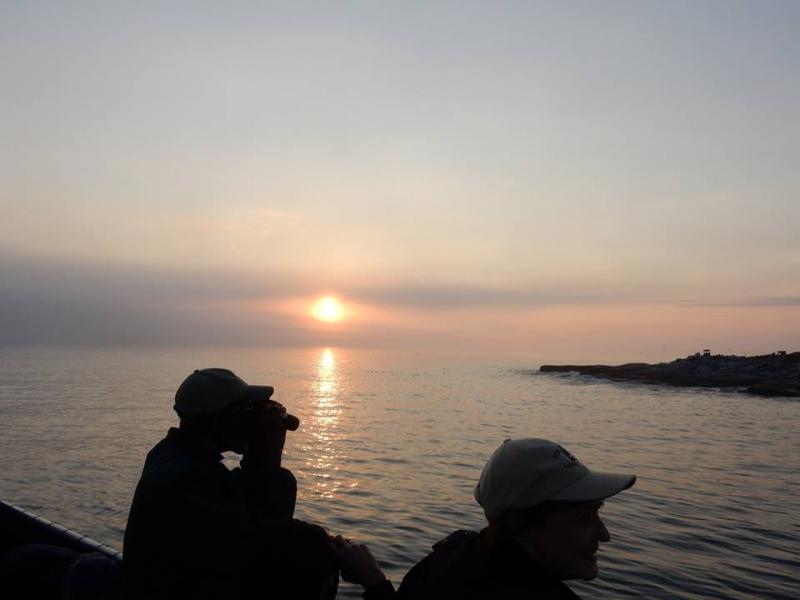After having to postpone an originally scheduled Natural Resources Council of Maine (NRCM) trip to Eastern Egg Rock aboard the Hardy Boat from New Harbor, it was a delight to sail last Friday evening on calm seas with more than 80 NRCM members hoping to see a puffin! Things started with concern as the boat’s regularly scheduled puffin cruise, prior to ours, had great difficulty finding any puffins and had to stay around Eastern Egg Rock an extra 20 minutes to find just a few. Still, the excellent crew boarded our hopeful group in record time, and under gorgeous evening light we steamed out of New Harbor with Captain Al at the helm and “Puffin Pete” Salmansohn on the microphone.
Pete has been working with National Audubon’s Project Puffin for decades and is well-known from his years of teaching school kids and adults about seabirds in classrooms, at the Hog Island camp, and on countless puffin watch cruises from both New Harbor and Boothbay Harbor. Pete has even co-authored a few books on the project with famed project director Steve Kress.
As we headed out across Muscongus Bay toward the tiny, flat, and jagged Eastern Egg Rock, a few harbor seals observed us with curiosity, a group of three to four summering common loons (probably immature birds waiting until next summer to start breeding) floated by; a massive, mostly white northern gannet flew over the bow, a Cory’s shearwater cruised low over the water in the distance. And then, seemingly without warning, we were enveloped in a fog so thick that we could only see a few feet from the boat.
Pete continued with his interesting tale of how more than 40 years ago, Steve Kress, then a young graduate student at Cornell University, had the idea of trying to restore puffin colonies that had been lost more than 100 years ago. Seabird colonies on the Maine coast had served as “grocery stores” for people who lived and worked along the coast. Over time, the constant depredations of eggs, young, and adult birds confined remaining seabirds to only a few of the most remote islands. Gulls were the seabirds that rebounded most quickly after protections were given to them 100 years ago, with the signing of the Migratory Bird treaty with Canada. With their ability to take advantage of human food waste at dumps and tossed off fish remains at canneries and fishing boats, herring gulls and great black-backed gulls prospered and established nesting colonies on many of the previously depleted islands. Unfortunately, birds like Atlantic puffins (that’s their official name) are more specialized in their foraging habits and are reliant on natural fish populations, many of which were decimated by heavy fishing pressures. They also typically only lay a single egg each year, so populations are very slow to grow.
Steve Kress began airlifting puffin nestlings from a healthy population in Newfoundland, and he and his compatriots hand fed them in little burrows they made on Eastern Egg Rock. After years and years of such efforts, these young puffins grew up and eventually came back. Over decades this work resulted in what is now a thriving Atlantic puffin colony on Eastern Egg Rock, with 150 nesting pairs in 2015.
As Pete was finishing this story and as if on cue, the island emerged from the fog about 500 yards in front of us. Most amazing, just in front of the boat, a flock of at least 20 puffins appeared, sitting on the water. Just ahead of them was another similarly sized flock! As we continued slowly motoring around the sound end of the island, flock after flock appeared, providing such close views that no binoculars were ne-eded. Other puffins could be seen standing on the rocks of the island. Others came flying in with tiny fish in the big orange bills. Captain Al was amazed and announced on the loudspeaker that this was the most puffins he had seen there on any of his trips. We estimated that we saw well over 120 puffins in our 30 minutes or so around the island.
As the boat pointed its bow back toward the mainland, the fog cleared and a gorgeous orange sunset glowed over 80 happy Natural Resources Council of Maine puffin watchers.
You can view the fantastic photo album at the NRCM Facebook page at https://www.facebook.com/NRCMenvironment/photos/?tab=album&album_id=10153628678591610
Jeffrey V. Wells, Ph.D., is a Fellow of the Cornell Lab of Ornithology. Dr. Wells is one of the nation's leading bird experts and conservation biologists and author of the “Birder’s Conservation Handbook.” His grandfather, the late John Chase, was a columnist for the Boothbay Register for many years. Allison Childs Wells, formerly of the Cornell Lab of Ornithology, is a senior director at the Natural Resources Council of Maine, a nonprofit membership organization working statewide to protect the nature of Maine. Both are widely published natural history writers and are the authors of the book, “Maine’s Favorite Birds.”
































.png)
.png)
